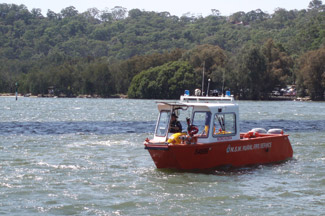fighting fires using boats
Fighting fire utilising boats is quite different from using trucks. Almost by definition, there is an unlimited supply of water, and the Brigade only uses 65mm and 38mm hose. On the negative side, fires are almost always burning up hills, is some cases almost impossible to climb, which results in rapid fire progression and higher flame heights. This results in long hose lays and relay pumping in order to catch and control a fire.
An upwind flank attack is usually the only viable method to control a fire. Once a boat lands and commences pumping operations, it essentially becomes a fixed pump and lacks the ability of a truck to follow a fire unless it is restricted to the shoreline.
Gaining access to fires can also be difficult. The boat may not be able to land crews directly on the shore, and the crews may have have to carry equipment through muddy reed banks or mangroves. We have had instances where there has been no firm ground to set down a portable fire pump, and have had to lash it in a tree so that it could be operated.
Cleaning equipment after a fire can take quite a few hours. Salt water has to be flushed from all the pumps, hoses and fittings; boats and outboard motors have to be thoroughly cleaned; 5000 feet of hose dried and rerolled. Most hose fittings will quickly seize if any trace of salt is left on them and canvas hose laden with salt has a vastly reduced service life.
Compared with land based brigades, boat crews have to be prepared to dedicate many extra hours to build and maintain specialised equipment, in addition to the extra training required for handling boats. See Provisonal Standards of Competency for Fireboat Crews.


